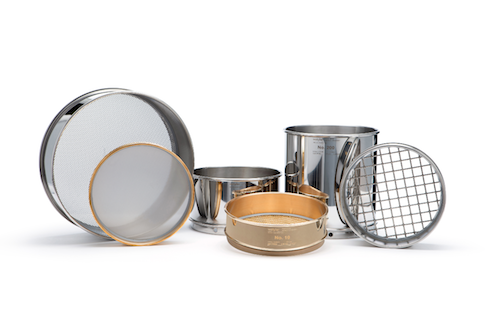5 Tips for Maintaining Your Test Sieves (Best Practices and Cleaning + Video)
"How do I clean my sieves?"
If you use test sieves during your day, you may have asked yourself these questions before.
We get these types of questions a lot from our customers, and we want to help you better understand how to clean and use your sieves.
Test sieves are technical instruments used to separate particles. They are used all over the world, in every industry.
They can be used for fine powders or abrasive materials like in the agricultural or mining industries. Regardless of what you are sieving, it is important to take proper care of your sieves.
As a customer and user, you want to get the longest life out of your sieves. More importantly, if your sieve falls out of spec (gets clogged or damaged) you are not going to be meeting your quality standards. This can cost your company money and time, and nobody wants that.
We have written this article to help you better understand the things you can do to ensure the life of your sieve and make sure it stays in top condition. We will be covering cleaning, inspections, usage, storage, and certification in the next few sections.
1. Regular Visual Inspections
The first tip we have is to be sure you are doing regular visual inspections of your sieves. This is an easy way to be sure you are checking that your sieves haven't suffered any wear and tear recently that will alter the analysis.
We recommend that you do a visual inspection on a schedule that you determine base on your needs. Here are the things you should be looking for during a visual inspection:
Dents in the Mesh
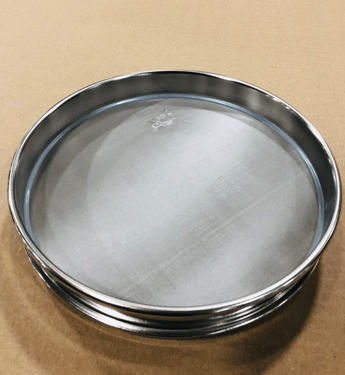
This should be one of the easier things to spot when looking at the sieve. By holding the sieve up to good light you should be able to see that the mesh is still pulled tightly across the entire surface.
You can see in the picture above this sieve has a section that is damaged and dented.
If you see spots that look like they are dented, you will not want to continue to use this sieve in your process. Dents in the mesh can cause the openings in the mesh to stretch out or change size. This is going to impact the accuracy of your tests.
Scratches in the mesh
Just like with dents in the mesh, you should be visually inspecting your sieves to see if there are any scratches. The scratches can cause tears or rips in the mesh and this can alter your sieve analysis.
Cracks in the Epoxy
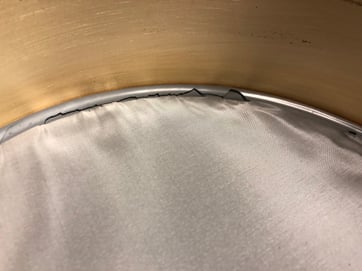
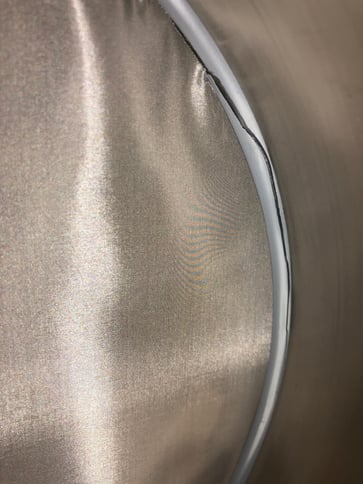
The epoxy is the gray substance that is used to hold the mesh of the sieve onto the frame. It looks like clear rubber cement or glue. You should check the edges of the sieve, where the mesh meets the metal, and make sure there are no cracks in it.
The two images above are of sieves that were sent back to us by a customer after they had used them for a period of time. You can see in both images there are very prominent cracks in the epoxy. If this happens to your sieves, it can allow more particles to go through the sieve than are supposed to. This will skew your testing results.
2. Sieving Correctly
One of the best ways to keep your sieves in their top condition is to be sure you are using them correctly. It is not uncommon for us to hear that customers are misusing sieves. There are a few ways you could be using your sieve incorrectly.
-
Pushing Particles through the sieve
If you are hand sieving, you should not be putting an excessive amount of pressure on the mesh in the sieve to push particles through.
2. Placing too much of your sample or too many particles on the sieve at once.
Doing this could cause blinding. Blinding occurs when the holes in the sieve get clogged up. This stops the particles from free flowing through the mesh and will skew results.
3. Cleaning your sieves
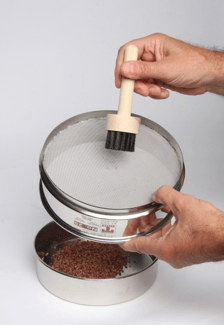
This may be the most important thing to know when it comes to using and maintaining your sieves. We are going to break cleaning down into five steps and then talk about what soap and utensils you should use.
Test sieves should be cleaned after each use to ensure that the next sample run through the sieve is done properly.
How to clean a sieve:
-
Turn the test sieve over a receiving pan
-
Gently brush the underside of the mesh using a circular motion
-
Gently tap the sieve frame with the brush handle to remove any particles that may cling to the frame
-
Wash sieves in warm water and a mild detergent solution
-
Allow adequate time for the sieve to dry before using.
Soap or cleaning solution
We recommend you use a mild cleaning solution to clean your sieves. We usually recommend a dish detergent like Simple Green.
Brushes
It may seem like you can grab any brush and scrub your sieve, but we highly recommend you don’t do this. It is important that you use a brush that is not going to be too hard on the wire mesh but that still gets the mesh clean.
Be sure you are purchasing a brush that is specifically intended for use with sieve cleaning.
Ultrasonic Cleaners
Sometimes with finer mesh sieves, it can be hard to get them clean because the openings are too small. If this might be the case for you, you can use an ultrasonic cleaner to clean your sieves. This machine is designed to vibrate and clean sieves that have small openings. If this interests you, you can read all about our ultrasonic cleaner here.
Important Don’ts
There are a few things you should not do when it comes to sieve cleaning:
- We don’t recommend using an oven to dry your sieves or a dishwasher to clean them; this can damage the sieve.
- Don’t use air pressure to clean your sieves; this can damage the mesh
- Don’t force particles out of the openings with a brush or your hands when cleaning
- Don’t use acidic solutions to clean the sieves
- Don’t try to repair the sieve
4. Storing Your Sieves
This one is pretty simple: test sieves need to be stored in a clean, dry, and controlled environment.
In order to keep the sieve in its optimal condition, it cannot be stored in a wet place or in a rapid temperate changing environment.
This could damage the sieve, especially the epoxy in the sieve which could result in failed testing.
5. Recertifying Your Sieves
The best ways to ensure your test sieves are meeting your industry standards is to send your sieves in for recertification.
As stated in the video above, a test sieve certification is a statement or verification that a sieve meets or exceeds written standards. It is an assurance that a sieve was manufactured to (and performs to) a certain level of performance.
To certify a test sieve, the sieve is first examined visually to look for tears, wavy mesh or cracked epoxy. Next, the sieve is scanned under a microscope that looks at a certain number of openings in the mesh to make sure they are not stretched or clogged and verifies the wire diameter.
If the sieve meets the level of certification required, it passes and is provided back to you with a verification of the openings and other technical information. If the sieve does not pass, you will be informed and can purchase new sieves.
We have a schedule we provide that states how often you should send your test sieves back in for recertification.
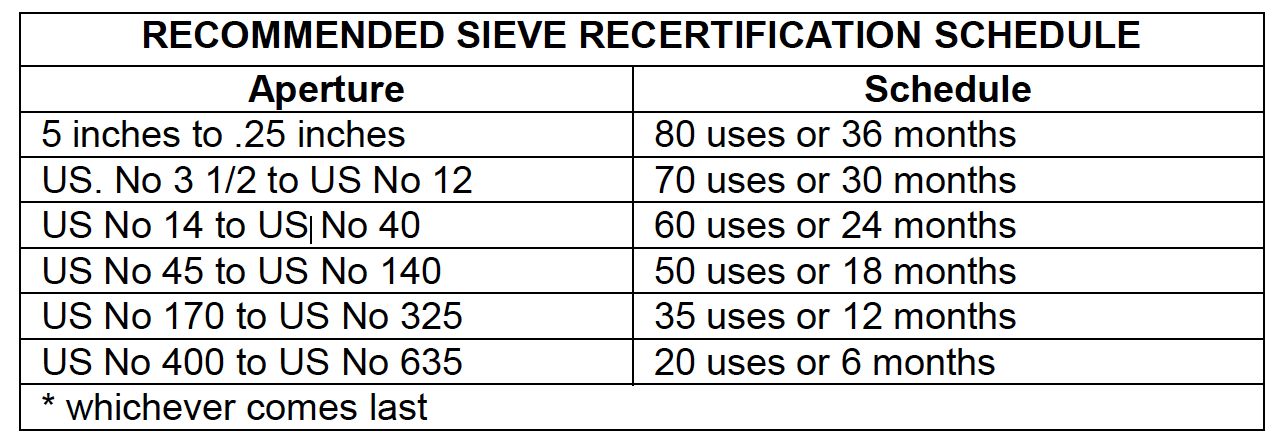
You can learn all about how certification works and how to know when you need to recertify your sieves in our last article: what is test sieve certification?
To Sum it All Up
We covered quite a few ways that you can be ensure you are getting the most out of your test sieves while meeting your standards.
You should do things like visual examinations and cleaning regularly to prolong the life of your sieve and to help it stay in spec longer.
The best way for you to ensure your sieves are in spec is to send them in for recertification. This is essentially a fool proof way to manage your sieves. You can register to have your sieves sent in and recertified by us here.
If you have any other questions about cleaning or maintaining your sieves, feel free to give us a call and we would love to chat about it with you.

